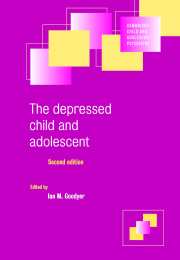Book contents
- Frontmatter
- Contents
- List of contributors
- Preface
- 1 Historical aspects of mood and its disorders in young people
- 2 The development of emotional intelligence
- 3 Developmental precursors of depression: the child and the social environment
- 4 Physiological processes and the development of childhood and adolescent depression
- 5 Childhood depression: clinical phenomenology and classification
- 6 The epidemiology of depression in children and adolescents
- 7 Family–genetic aspects of juvenile affective disorders
- 8 Life events: their nature and effects
- 9 Adolescent depression: neuroendocrine aspects
- 10 Suicidal behaviour in adolescents
- 11 Psychopharmacology of depressive states in childhood and adolescence
- 12 The psychotherapeutic management of major depressive and dysthymic disorders in childhood and adolescence: issues and prospects
- 13 Natural history of mood disorders in children and adolescents
- Index
3 - Developmental precursors of depression: the child and the social environment
Published online by Cambridge University Press: 18 December 2009
- Frontmatter
- Contents
- List of contributors
- Preface
- 1 Historical aspects of mood and its disorders in young people
- 2 The development of emotional intelligence
- 3 Developmental precursors of depression: the child and the social environment
- 4 Physiological processes and the development of childhood and adolescent depression
- 5 Childhood depression: clinical phenomenology and classification
- 6 The epidemiology of depression in children and adolescents
- 7 Family–genetic aspects of juvenile affective disorders
- 8 Life events: their nature and effects
- 9 Adolescent depression: neuroendocrine aspects
- 10 Suicidal behaviour in adolescents
- 11 Psychopharmacology of depressive states in childhood and adolescence
- 12 The psychotherapeutic management of major depressive and dysthymic disorders in childhood and adolescence: issues and prospects
- 13 Natural history of mood disorders in children and adolescents
- Index
Summary
Introduction
An episode of clinical depression during childhood or adolescence has a negative impact on social, academic and family functioning, as well as being associated with an increased risk for recurrence (McCauley & Myers, 1992) and impairment in social-emotional functioning that extends into adult life (Harrington et al., 1990). Efforts to identify effective prevention and treatment strategies for depression in children are ongoing (Myers & McCauley, 1997). Prevention and treatment approaches need to be informed by a developmentally sensitive understanding of the mechanisms that underlie the onset of depression in young people.
Understanding the underpinnings of clinical depression is a complex task, which must include consideration of a multitude of factors. Depression is not simply a disorder of mood regulation but involves alterations in physiological and cognitive functioning. Moreover, the study of depression requires careful attention to developmental issues, especially the challenges of adolescence. While the general incidence of psychopathology increases only moderately during the adolescent years, the frequency of depression increases significantly, particularly in females (Rutter et al., 1976; Lewinsohn et al., 1993; Hankin et al., 1998). Furthermore, recent research suggests a discontinuity between prepubertal and postpubertal depression. Depression which first presents during the prepubertal period appears to be more strongly linked to environmental factors while postpubertal depression is best explained by a model of interaction between genetic and environmental factors (Thapar & McGuffin, 1996). More importantly, prepubertal depression represents a strong, but nonspecific risk for adult adjustment problems whereas adolescent depression is strongly linked to recurrent depressive episodes during adult life (Harrington et al., 1996).
Keywords
- Type
- Chapter
- Information
- The Depressed Child and Adolescent , pp. 46 - 78Publisher: Cambridge University PressPrint publication year: 2001
- 35
- Cited by



